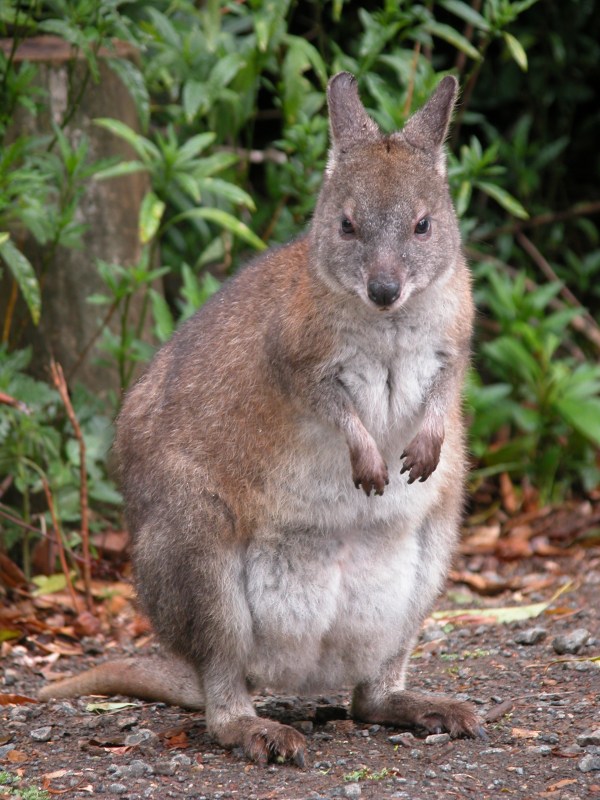- Pademelon
Taxobox
name = PademelonsMSW3 Groves|pages=69-70]

image_width = 200px
regnum =Animal ia
phylum = Chordata
classis =Mammal ia
infraclassis =Marsupial ia
ordo =Diprotodontia
familia =Macropodidae
subfamilia =Macropodinae
genus = "Thylogale"
genus_authority = Gray, 1837
type_species = "Halmaturus (Thylogale) eugenii"
type_species_authority = Gray, 1837
(= "Halmaturus thetis" Lesson, 1828)
subdivision_ranks =Species
subdivision =
* "Thylogale billardierii"
* "Thylogale browni"
* "Thylogale brunii"
* "Thylogale calabyi"
* "Thylogale lanatus"
* "Thylogale stigmatica"
* "Thylogale thetis"A pademelon is any of seven species of small
marsupial s of thegenus "Thylogale". They are usually found in forests. Pademelons are the smallest of themacropod s. The name is a corruption of "badimaliyan", from theDharuk Aboriginal language ofPort Jackson .Pademelons, wallabies, and
kangaroo s are very alike in body structure, and the names just refer to the three different size groups. Originally wallabies were divided into small and large wallabies, but a more suitable name was needed to differentiate between them.Besides their smaller size, pademelons can be distinguished from wallabies by their shorter, thicker, and sparsely haired tails.
Distribution and habitat
Red-necked Pademelon s can be found in the coastal regions ofQueensland andNew South Wales . In some places their range has been drastically reduced.Red-legged Pademelon s can also be found in south-centralNew Guinea . The Red-bellied or Tasmanian Pademelon is abundant inTasmania . The Dusky Pademelon lives inPapua New Guinea and surrounding islands. It was previously called the Aru Island Wallaby. Before that, it was called the Filander. This name occurred in a translation ofC. de Bruyns Travels published in1737 .The natural habitat of the pademelon is in thick scrubland or dense forested undergrowth. They also make tunnels through long grasses and bushes in swampy country.
Diet and behaviour
If there are no predators, such as dogs, they graze in the early mornings or evenings on grassy slopes near thickets into which they can quickly escape at the first sign of danger. Having noticed danger, such as a python, they may try to warn others by stomping their feet on the ground producing surprisingly loud sound. Pademelons are nocturnal and tend to feed at night.
Their main diet is made up of grasses, leaves, and small shoots. They do little damage to crops and are not as aggressive as wallabies and kangaroos can be, making them gentle pets.
Normally, a group of females would stay on the territory with males showing up, only when one of the females is ready for mating. This is in contrast to the behavior of bigger kangaroos, who stay in mixed mobs with a male leader.
Problems faced
Pademelon meat used to be considered valuable and was eaten by settlers and aborigines for a long time. It was once suggested that they be introduced to France as a meat supply.Fact|date=March 2007 Although their meat is very low in fat and cholesterol (like that of all kangaroos), most Australians consider it no more than "second grade" and strongly prefer lamb and beef instead.Fact|date=March 2007
Aside from being killed for their meat and soft fur, their numbers have been reduced by the introduction of predators such as feral cats, dogs, and foxes. The rabbit explosion has also caused problems, as rabbits graze on the same grasses making less available for the pademelon. Also, clearing of land for homes has pushed the larger wallabies and kangaroos into land that pademelons had been thriving in for so long.
Tasmanian Pademelons were important to the
Thylacine 's diet, and are still preyed on byquoll s,Tasmanian Devil s, pythons, andWedge-tailed Eagle s. Despite these predators, there are many in Tasmania and its outlying smaller islands, and every year many are killed off to keep their numbers down.pecies
* Genus "Thylogale"
**Tasmanian Pademelon , "Thylogale billardierii"
**Brown's Pademelon , "Thylogale browni"
**Dusky Pademelon , "Thylogale brunii"
**Calaby's Pademelon , "Thylogale calabyi"
**Mountain Pademelon , "Thylogale lanatus"
**Red-legged Pademelon , "Thylogale stigmatica"
**Red-necked Pademelon , "Thylogale thetis"References
Wikimedia Foundation. 2010.
